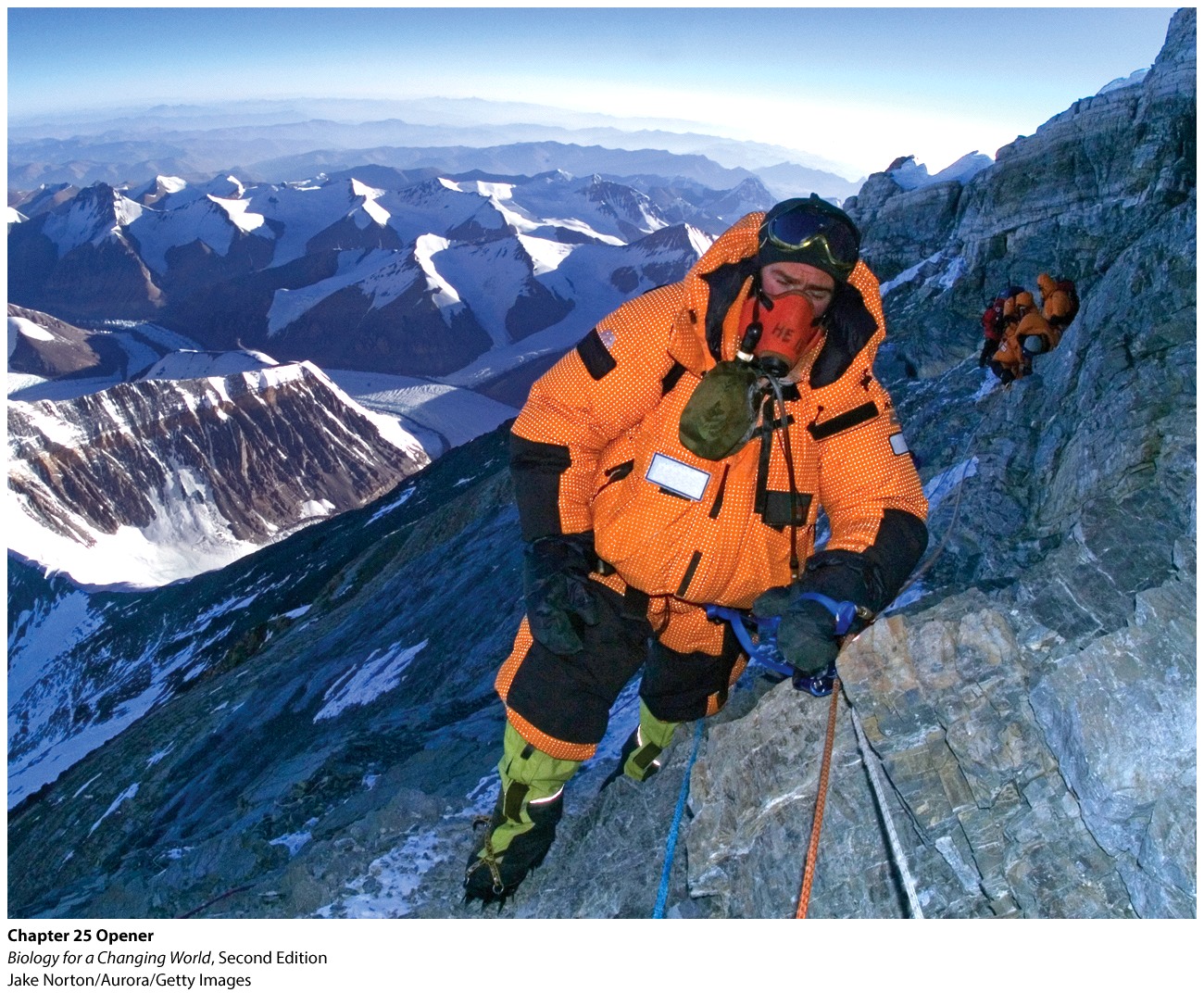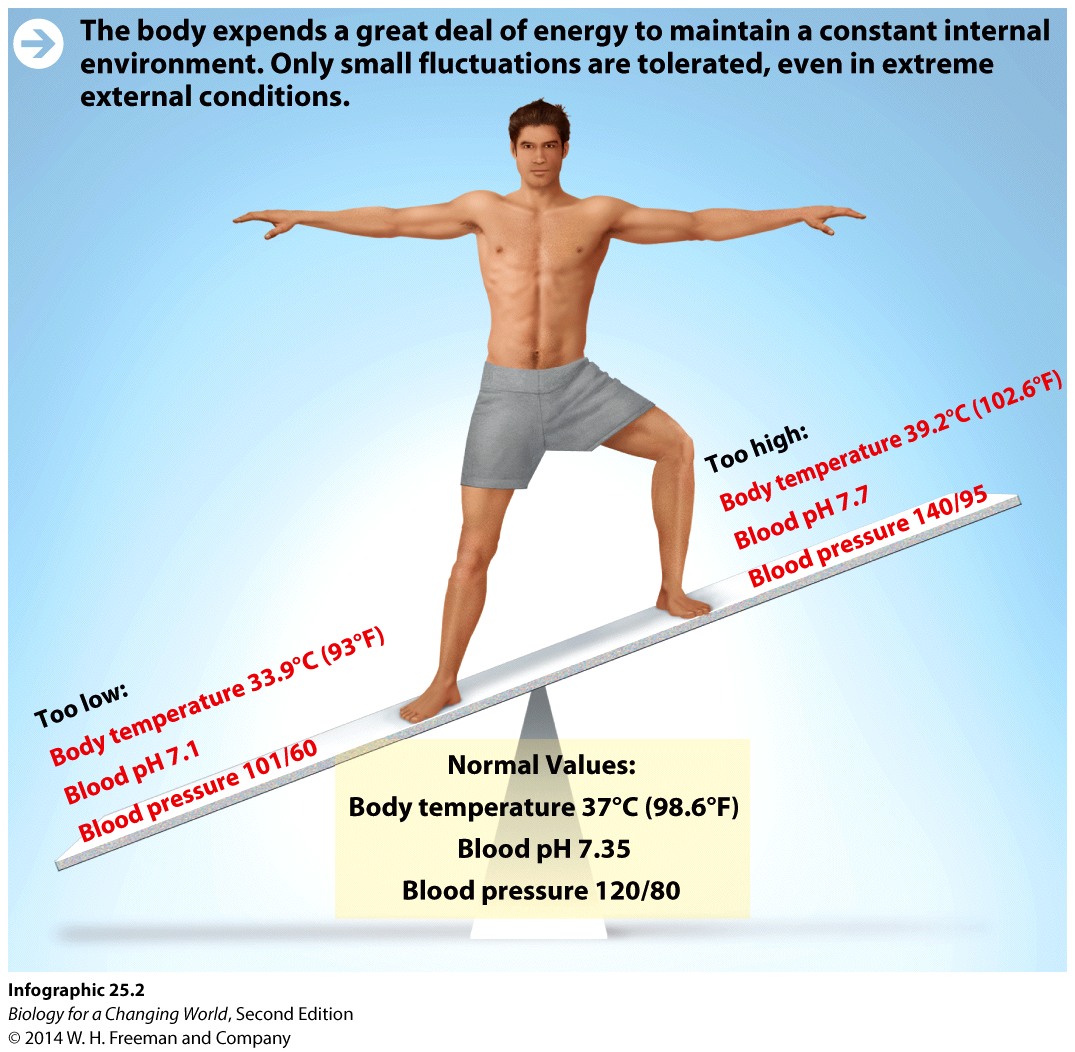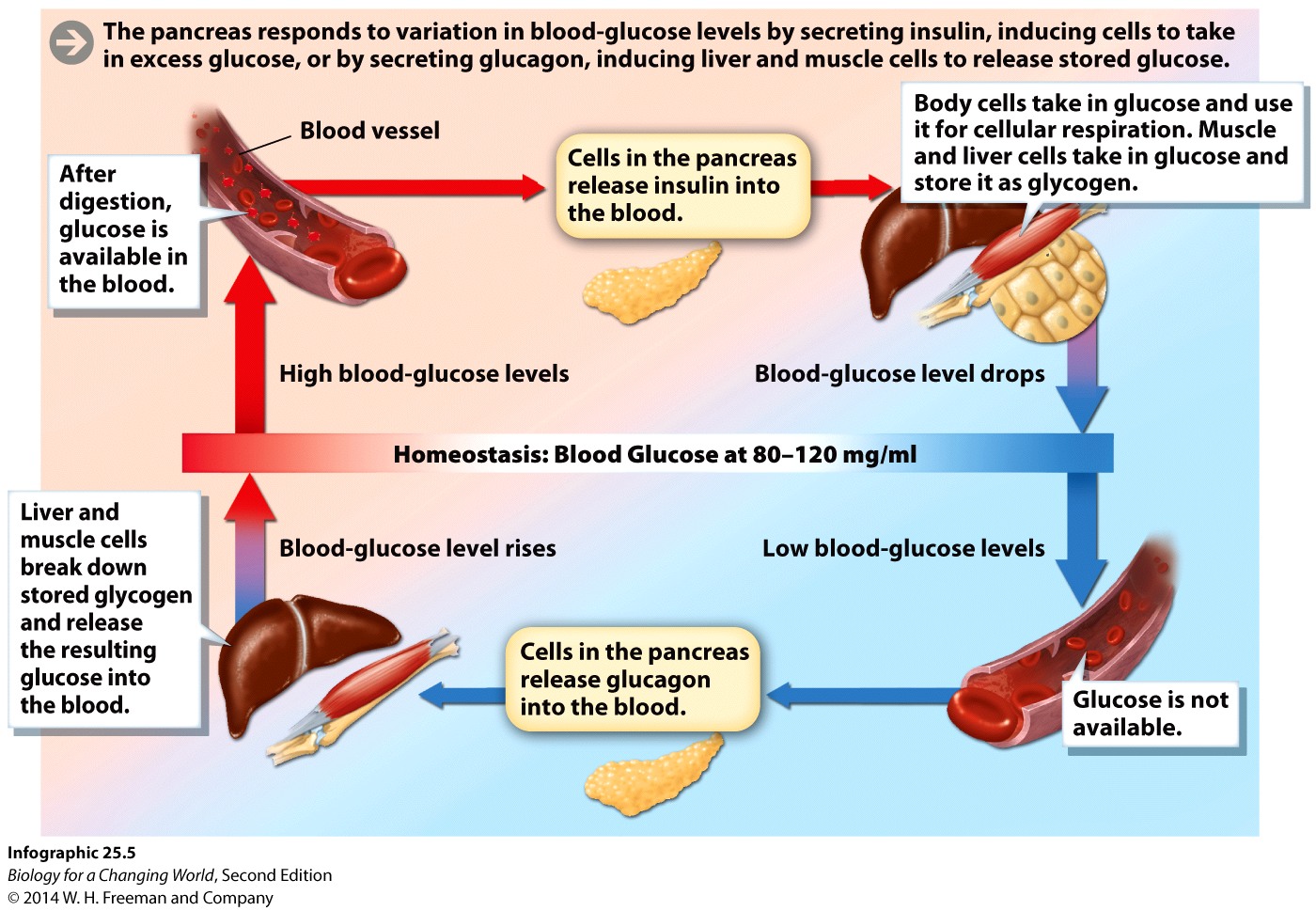
Chapter 1. Chapter 25: Overview of Physiology
1.1 Introduction


Welcome to the Interactive Study Guide for Chapter 25: Overview of Physiology! This Study Guide will help you master your understanding of the chapter's Driving Questions, using interactive Infographics and activities, as well as targeted assessment questions. Click "Next" to get started, or select a Driving Question from the drop-down menu to the right.
Man Versus Mountain:
Physiology explains a 1996 disaster on Everest
DRIVING QUESTIONS
- How are the bodies of living organisms organized?
- How do humans and other organisms regulate body temperature?
- What physiological systems are regulated by homeostatic feedback loops?
1.2 Driving Question 1:
Driving Question 1
How are the bodies of living organisms organized?
Why should you care?
Your anatomy is made up of different kinds of cells that form tissues, which form organs, which form organ systems, which form your body. Understanding the organization of your body and the parts involved is a crucial part of understanding your health.
What should you know?
To fully answer this Driving Question, you should be able to:
- Describe the relations among cells, tissues, organs, and organ systems.
- Describe examples of various types of cells and tissues.
Infographic Focus
The Infographic most pertinent to the Driving Question is 25.1.
Test Your Vocabulary
Choose the correct term for each of the following definitions:
| Term | Definition |
|---|---|
| A structure made up of various tissue types working together to carry out a common function. | |
| An organized collection of a single cell type working to carry out a specific function. | |
| The study of the physical structures that make up an organism. | |
| The study of the way a living organism’s physical parts function. | |
| A set of cooperating organs. |
Describe the relations among cells, tissues, organs, and organ systems.
1.
Create an anatomical organization scheme by filling in the table with an example of:
- a cell type.
- a tissue that contains cells of this type.
- an organ that contains this tissue type.
- an organ system that contains this organ.
- an organism that contains this organ system.
Then explain how each anatomical structure is different from its neighbor in the organizational scheme.
| Structure | Example | How is each anatomical structure different from the one below it? |
| Cell type |
Fill in: |
Fill in: |
| Tissue that contains the cell |
Fill in: |
Fill in: |
| Organ that contains the tissue |
Fill in: |
Fill in: |
| Organ system that contains the organ |
Fill in: |
Fill in: |
| Organism that contains the organ system |
Fill in: |
Fill in: |
| Structure | Example | How is each anatomical structure different from the one below it? |
| Cell type | Cone | A cell is the smallest unit of life in the body. It cannot be broken down into its components and still maintain life. |
| Tissue that contains the cell | Retina | A tissue is a collection of one cell type. |
| Organ that contains the tissue | Eye | An organ is a collection of tissue types working together. |
| Organ system that contains the organ | Nervous system | Organ systems are composed of various organs, all working together to perform a vital task. One organ system alone, however, cannot maintain life. |
| Organism that contains the organ system | Rabbit | An organism is composed of all organ systems working together to maintain life. |
Incorrect
Describe the four basic types of cells and tissues generally found in animals.
2.
List the four basic cell types of animals and the names of the corresponding tissues they make up.
| Cell Type | Corresponding Tissue Type |
Try again.
Correct
Incorrect
3.
What is the pattern between cell type and tissue type names?
4.
How can an organ be made up of both cells and tissues?
Review Questions
5.
Different _____ working together for a common function make up a(n) _____.
| A. |
| B. |
| C. |
| D. |
6.
Which anatomical structure is the most diverse in terms of cell types?
| A. |
| B. |
| C. |
| D. |
1.3 Driving Question 2:
Driving Question 2
How do humans and other organisms regulate body temperature?
Why should you care?
Your home has features like thermostats, air conditioners, pressure regulators, water heaters, and insulation that all work to maintain constant conditions in it. Just like a house, your body maintains relatively constant conditions in several ways. Many diseases, for example diabetes, result from faulty regulation of conditions in the body. Knowing about homeostasis—how the body maintains a constant state—can help us understand how to take better care of our own health.
Your body uses several processes to maintain a constant body temperature. When the outside temperature is extremely cold, the body works to maintain a constant internal temperature by conserving the heat it has and generating additional heat. When the outside temperature is extremely hot, the body also works to maintain a constant internal temperature by expelling heat and sweating. Learning about thermoregulation will give you insight into how organ systems in your body work cooperatively to maintain homeostasis.
A feedback loop is a cyclic pathway of sensing and effecting that works to regulate something in the body. When that something is body temperature, the sensing is done by thermosensors, special nerves in outer layers of the skin, and the effecting is done by muscles and blood vessels. Learning about how body temperature is regulated could help you avoid behaviors that will lead to either hypothermia or overheating. For example, alcohol is often suggested as a means to warm up in cold weather, but it actually works as a vasodilator, bringing more blood to the skin, where it initially makes a person feel warmer but will quickly lead the blood to cool as it gives off its heat.
What should you know?
To fully answer this Driving Question, you should be able to:
- List the conditions that the human body keeps relatively constant to maintain homeostasis.
- Explain the various processes involved in maintaining a constant body temperature in response to cold and heat.
- Identify the components and processes involved in the feedback loop that is responsible for thermoregulation in humans.
Infographic Focus
The Infographics most pertinent to the Driving Question are 25.2 to 25.4.
Test Your Vocabulary
Choose the correct term for each of the following definitions:
| Term | Definition |
|---|---|
| A pathway that includes input from a sensor, a response via an effector, and detection of the response by the sensor. | |
| The maintenance of a relatively stable internal environment even when the external environment changes. | |
| The reduction in diameter of blood vessels, which helps to retain heat. | |
| A cell that detects specific sensory input, such as temperature, pressure, or solute concentration. | |
| The maintenance of a relatively stable internal body temperature. | |
| A cell or tissue that acts to exert a response on the basis of information relayed from a sensor. | |
| A master coordinator region of the brain responsible for a variety of physiological functions. |
List the conditions that the human body keeps relatively constant to maintain homeostasis.
7.

Without looking at Infographic 25.2, list some of the conditions in the human body that are kept relatively constant in healthy people. Then refer to Infographic 25.2 and fill in any conditions you might have missed.
Why is it important for the body to regulate these conditions? Fill in your answers next to the conditions.
| Condition Maintained at a Constant Level in the Body | Reason It Is Important to Maintain This Condition Constant |
|
Fill in: |
Fill in: |
|
Fill in: |
Fill in: |
|
Fill in: |
Fill in: |
| Condition Maintained at a Constant Level in the Body | Reason It Is Important to Maintain This Condition Constant |
| Body temperature | Proteins (including enzymes) can function only in a small window of optimal temperature. |
| Blood pH | Proteins (including enzymes) can function only in a small window of optimal pH. |
| Blood Pressure | If your blood pressure is too low, not enough blood will get to your brain and organs. If your blood pressure is too high, you may rupture a vein or artery. |
Explain the various processes involved in maintaining a constant body temperature in humans.
8.
Consider shivering and vasoconstriction. Which one conserves heat, and which one generates heat? How do they accomplish this?
9.
Now, consider vasodilation and sweating, the two main ways your body prevents overheating. How do these processes work to prevent overheating? How are they similar to and how are they different from vasoconstriction and shivering?
Identify the components and processes involved in the feedback loop that is responsible for thermoregulation in humans.
10.
Place the listed events in the order in which they would occur for the given scenario.
You are camping in northern Minnesota at the end of October, when temperatures can dip below freezing (32°F) during the night. Your campfire goes out while you are sleeping and you wake up shivering but soon feel warm again. Place the statements in the order that they likely occurred.
| Hypothalamus detects temperature change and receives signal from thermosensors | |
| Thermosensors in the skin detect a change | |
| Body maintains appropriate temperature | |
| Vasoconstriction occurs in limbs | |
| Muscles contract involuntarily (shivering) | |
| Hypothalamus detects temperature change and no longer receives signals from thermosensors. | |
| Temperature drops and body becomes cold | |
| Internal body temperature rises | |
| Hypothalamus sends signals to effectors | |
| Thermosensors in the skin detect a change again |
11.
What are the sensors and effectors in this scenario?
12.
What would be the sensors and effectors if the scenario described a situation in which your body is overheating?
Review Questions
13.
Which of the following is NOT maintained by homeostasis in humans?
| A. |
| B. |
| C. |
| D. |
| E. |
14.
When the body gets too cold, the ____________ send(s) signals to the hypothalamus, which in turn signal(s) the ____________.
| A. |
| B. |
| C. |
| D. |
| E. |
15.
Which processes are involved in maintaining an appropriate body temperature in humans? Choose all that apply.
| a. sweating | |
| b. shivering | |
| a. vasoconstriction | |
| a. pupil dilation |
1.4 Driving Question 3:
Driving Question 3
What physiological systems are regulated by homeostatic feedback loops?
Why should you care?
Feedback loops in your body continually survey and measure various elements inside and outside of your body to maintain optimal functioning of your organ systems and therefore your body as a whole. Maintaining homeostasis is important, as even a slight tip in that balance in either direction could have dire consequences for your overall health. Two examples of homeostatic feedback loops are the loop that maintains blood glucose levels and the loop that regulates the pressure, solute concentration, and water concentration of your blood.
What should you know?
To fully answer this Driving Question, you should be able to:
- Describe the components and processes in the feedback loop that is responsible for blood glucose level regulation in humans.
- Describe the components and processes in the feedback loop that is responsible for osmoregulation in humans.
- Explain what happens when glucose levels and osmolarity are not well regulated.
Infographic Focus
The Infographics most pertinent to the Driving Question are 25.5 and 25.6.
Test Your Vocabulary
Choose the correct term for each of the following definitions:
| Term | Definition |
|---|---|
| An energy-storing carbohydrate found in liver and muscle. | |
| The organs that sense and respond to information, including the brain, spinal cord, and nerves. | |
| A hormone secreted by the pancreas that causes a decrease in blood sugar. | |
| The maintenance of relatively stable volume, pressure, and solute concentration of bodily fluids, especially blood. | |
| A chemical signaling molecule that is released by a cell or gland and travels through the bloodstream to exert an effect on target cells. | |
| The hormone-secreting glands and organs with hormone-secreting cells. | |
| A hormone produced by the pancreas that causes an increase in blood sugar. | |
| An organ involved in osmoregulation, filtration of blood to remove wastes, and production of several important hormones. | |
| An endocrine gland in the brain that secretes many important hormones. | |
| The concentration of dissolved solutes in blood and other bodily fluids. | |
| An organ that secretes the hormones insulin and glucagon and digestive enzymes. | |
| A drop of body temperature below 35°C (95°F), which causes enzyme malfunction and eventually death. |
Describe the components and processes involved in the feedback loop that is responsible for blood glucose level regulation in humans.
16.

Examine Infographic 25.5 and answer the following questions.
What two steps in the blood glucose level feedback loop result in a rise of blood glucose levels?
2. Liver and muscle cells break down stored glycogen into glucose.
17.
What two steps in the blood glucose level feedback loop result in a reduction of blood glucose levels?
2. Liver and muscle cells take in and store glucose as glycogen.
18.
In what situation is blood glucose most likely to drop?
19.
What organ and tissue store excess glucose, and in what form do they store it?
20.
What organ is responsible for monitoring blood glucose levels?
21.
What are the two hormones this organ produces, and what do they do?
Hormone 2: Glucagon signals liver and muscle cells to break down stored glycogen to release glucose in the bloodstream.
Describe the components and processes involved in the feedback loop that is responsible for osmolarity regulation in humans.
22.
Describe what happens when your body is dehydrated.
23.
How would your answer be different if your blood pressure were too high (too much water in the blood)?
Explain what happens when glucose levels and osmolarity are not well regulated.
24.
Type 1 diabetes is inability of the body to make insulin. How would this affect the regulation of blood glucose levels?
25.
A person can typically survive for an average of 3 weeks without food but only about 3 days without water. Why is dehydration such a problem for our bodies?
Review Questions
26.
The release of ____________ by the pancreas into the blood would be followed by ____________ in blood-glucose level.
| A. |
| B. |
| C. |
| D. |
| E. |
27.
Choose the correct sequence of events. Water volume ____________ in blood; release of ADH by the hypothalamus ____________; kidneys release ____________ water in the urine.
| A. |
| B. |
| C. |
| D. |
| E. |
28.
Explain how each condition results from either homeostasis in action or homeostasis being overwhelmed and why.
Hypothermia:
Having to make a frantic restroom stop after having a jumbo-sized soft drink:
Sweating after a tough gym class:
Activity results are being submitted...